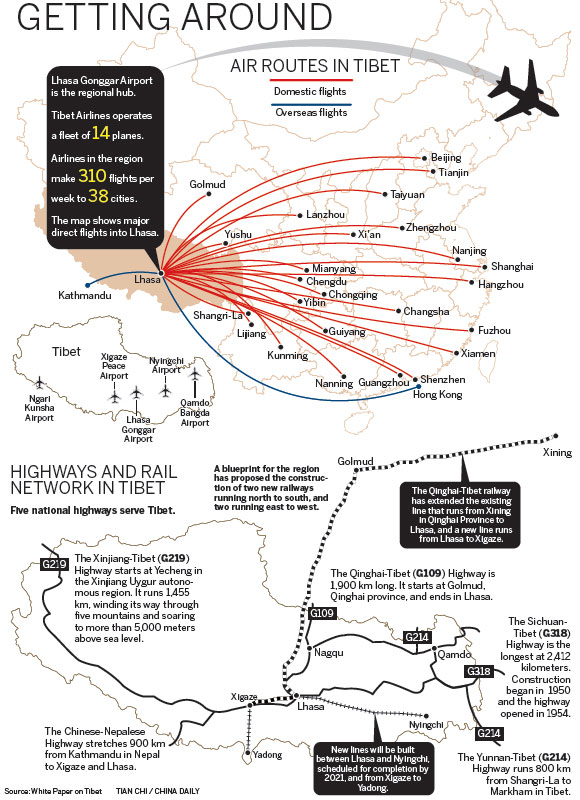No expense spared
|
 Passenger planes at the Lhasa Gonggar Airport in the capital of the Tibet autonomous region. Phurbu Tashi / Xinhua |
However, that sum was just a drop in the ocean of the total investment the government has made in Tibet's transportation infrastructure in the past 50 years. The local transportation authority said that in 1950 the region had no paved roads, but by the end of last year, 75,000 km had been constructed. Medog, the last county in China unconnected to the outside world by road, was linked to the national highway network in 2013.
In 2006, a railway was opened to link Lhasa, the capital of Tibet, with neighboring Qinghai province. The line was later extended as far as Xigaze, Tibet's second-largest city.
The region is mountainous, so it's expensive to build roads and railways. To compensate for this, civil airports were built in Lhasa, Qamdo, Nyingchi, Ngari and Xigaze, and nine airlines operate 310 flights per week to 38 cities.
The improvement of the transportation infrastructure has not only benefited the locals, but also brought a large number of visitors to Tibet, where tourism is a pillar industry.
The region's airports received 3.15 million visitors last year, and the tourism authority said the number of tourists has grown by as much as 30 percent annually since the Xigaze airport was opened in 2013.
The airport in Nyingchi was opened in 2006, and last year 1.52 million tourists visited the prefecture, generating revenue of 1.11 billion yuan, 11 times the amount in 2005.
The Lhasa-Xigaze railway, which opened on Aug 16 last year, has also carried large numbers of tourists to Xigaze, home of the mountaineers' base camp for Qomolangma, known in the West as Mount Everest.
Batsang, deputy director of the Xigaze Development and Reform Commission, said more than 40,000 visitors used the railway in the first month of operation.
The railways and roads will be extended to other parts of the region over time, and there are plans to build new railways to link Lhasa and Nyingchi, and to connect Xigaze with the counties of Gyirong and Yadong, which both boast stunning tourist attractions but are difficult to access.
"Many tourists want to travel in Tibet, but in the past they were discouraged by the limited transportation options available. As the options increase, visitors will have access to many more attractions that are just waiting to be explored," Phurbu Tashi, head of the Xigaze Tourism Bureau, said.

Related Stories